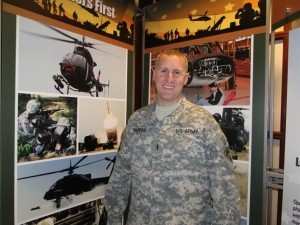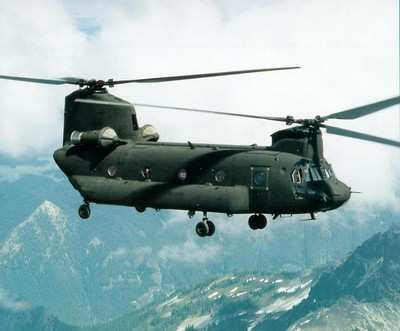Demonstrates New Chinook Technology To Pilots In Theater
Experimental test pilot Army Chief Warrant Officer Cary Nadeau
views his job as being the consumer advocate for Army aviators. And
like any good consumer advocate, he reaches out to his customers -
in his case, in combat zones.

Chief Warrant Officer Cary
Nadeau
Nadeau, 38, recently left for his fourth deployment - his third
to Iraq - as one of the Army's 30 experimental test pilots to show
Chinook pilots the benefits of new technology tested by the
Redstone Test Center here.
Chinook helicopters flown by pilots of the 25th Infantry
Division's 25th Combat Aviation Brigade are the first to be
equipped with a laser-based countermeasure system designed to shoot
laser energy at incoming infrared missiles to redirect them away
from the aircraft.
"It looks like two R2-D2 heads on the side of the aircraft,"
Nadeau said. "They provide an added layer of protection against
infrared missiles by using laser energy to spoof them or direct
them in a different direction. The lasers work automatically to
confuse the missile. It's all about increasing the survivability of
the aircraft."
Because of their limited number, experimental test pilots are
assigned only to brigades fielding equipment being used for the
first time on major systems or airframes. Nadeau has flown test
flights with the laser-based countermeasure system that he will
support in Iraq, and possibly Afghanistan, where he could be
transferred about midway through the deployment to support another
unit of Chinooks being equipped with the system. "Eventually, all
of the Army's Chinooks will have this system," he said.
Nadeau recently transferred to Redstone Arsenal as part of the
merger of Fort Rucker's Aviation Technical Test Center with the
Redstone Technical Test Center. He is assigned to the Redstone Test
Center to perform test flights on new technology for Chinook
helicopters.
During his six-month deployment, Nadeau said, his mission, first
of all, is to be a soldier. "Second, it is to embed with the
aviation brigade to impart my experience in flight testing," he
said. "My job is to dispel myths and rumors about the new
equipment, to train the soldiers on how the technology works and to
bring information back to Redstone Test Center on how well the
system is operating in real use situations," he explained. "I've
seen this system flown. I've seen it work against real live
missiles. I can impart that confidence to the pilots of the
25th."

File Photo
It's critical, when flying a Chinook, that the aircraft have the
"capability of protecting itself from outside forces," Nadeau said.
Geneva Convention rules prohibit medical evacuation Chinooks from
shooting back when fired upon, so their crews must rely heavily on
armed escorts and multilayered defense systems, he added.
Nadeau will serve as a liaison between the brigade and the test
center. "We're shifting this system from testing to now flying," he
said. "We will gain more experience from the pilots in Iraq that we
can use productively in the test community. This keeps us
relevant."
Nadeau's role is an offshoot of a program started after 9/11
when the Army Test and Evaluation Command and Fort Rucker's test
center used forward operational assessment teams in theater in
support of new technology. "ATTC realized then the importance to
staying relevant to the fight," Nadeau said. "We needed to look at
new systems in theater and help in the deployment of new systems."
Since then, commanders began requesting experimental test pilots
for their brigades.
"We offer a very good liaison capability between the brigade and
program managers, airworthiness managers and test managers," Nadeau
said. "We can get commanders things - information, technology and
equipment - that they can use in their brigades while in
theater."
Nadeau enlisted in the Air Force and served as a firefighter for
seven years before joining the Army's warrant officer program 12
years ago. He first deployed to Kosovo in 1999 and 2000, where he
flew Black Hawk helicopters. During his first deployment to Iraq in
2003, Nadeau served with the 507th Medical Company, assigned to the
Army's 3rd Infantry Division, where he flew Chinook medical
evacuation missions. "It was during the initial invasion, the main
push into Baghdad," he recalled. "It was real quick. Most of our
medevac missions involved soldiers who happened to get injured by a
mine in a field."
In his second deployment to Iraq, he flew a medevac Chinook for
the 1st Marine Division, mostly in the western regions of Fallujah
and Ramadi. "The enemy had gotten smarter, and there were a lot of
[improvised explosive devices]," he said. "Our bus picked up a lot
of Marines."
Nadeau left Oct. 24 for his third deployment to Iraq. Before
leaving Redstone, he met with Army Maj. Gen. Jim Myles, commander
of the Aviation and Missile Command, and aircraft program managers
to establish a rapport that will serve him well in his liaison
role. "The message I received from General Myles and all the
program managers is that they are there to support the warfighter
24/7," he said.
Besides supporting warfighters, Nadeau views his deployment as a
way to gain a better understanding of theater requirements. "I
think staying relevant is the big thing," he said. "We need to keep
our testers relevant to the current fight so that we keep our
credibility with the soldiers.

file Photo
"It's sort of a role reversal," he continued. "To stay credible
with soldiers and soldier pilots, I'm going over there to eat dirt,
walk my boots in the sand, fly missions and be a soldier with
them."
Although he will fly Chinooks and primarily support technical
issues involving the Chinook, Nadeau also supports technical
questions involving the unit's Black Hawk, Apache and Kiowa
helicopters. "Army pilots typically fly one airframe," he said.
"But as an experimental test pilot, those divisions go away, the
lines dissolve. I will be used where my expertise is, but I can
also work outside my expertise to provide a fresh view of any of
the airframes flown by the brigade."
For example, if a technical issue arises involving the brigade's
Apache helicopter, Nadeau has the expertise to get involved,
formulate the issue and communicate it back to program managers for
resolution. Being an experimental test pilot has allowed Nadeau to
get more involved in how the Army acquires new aircraft. "I fly a
plethora of different aircraft, and test lots of systems," he
said.
During experimental testing, pilots look for flaws in new
systems. Nadeau recently performed several test flights for a new
infrared exhaust suppressor that reduces the Chinook's heat
signature so that it is more difficult to detect by heat-seeking
missiles. During those tests, Nadeau discovered flaws in the
infrared exhaust suppressor system that resulted in a system
redesign. "We don't say 'Buy it' or 'Don't buy it,'" he said. "We
tell the good things, the bad things and the safety things about an
aircraft or its systems and subsystems. We answer questions like
'Is it safe?' and 'Does it function the way it is supposed
to?'"
Once his deployment is complete, Nadeau will return to Redstone
and resume flight testing for the test center. "The projects we
test are always changing," he said. "I will just fall right back
into the test schedule."
 ANN's Daily Aero-Linx (04.17.24)
ANN's Daily Aero-Linx (04.17.24) ANN's Daily Aero-Term (04.17.24): Jamming
ANN's Daily Aero-Term (04.17.24): Jamming ANN's Daily Aero-Linx (04.18.24)
ANN's Daily Aero-Linx (04.18.24) Aero-News: Quote of the Day (04.18.24)
Aero-News: Quote of the Day (04.18.24) ANN's Daily Aero-Term (04.18.24): Hold-In-Lieu Of Procedure Turn
ANN's Daily Aero-Term (04.18.24): Hold-In-Lieu Of Procedure Turn





